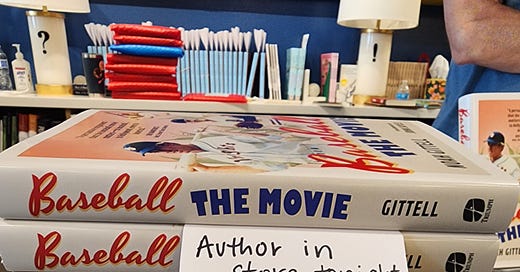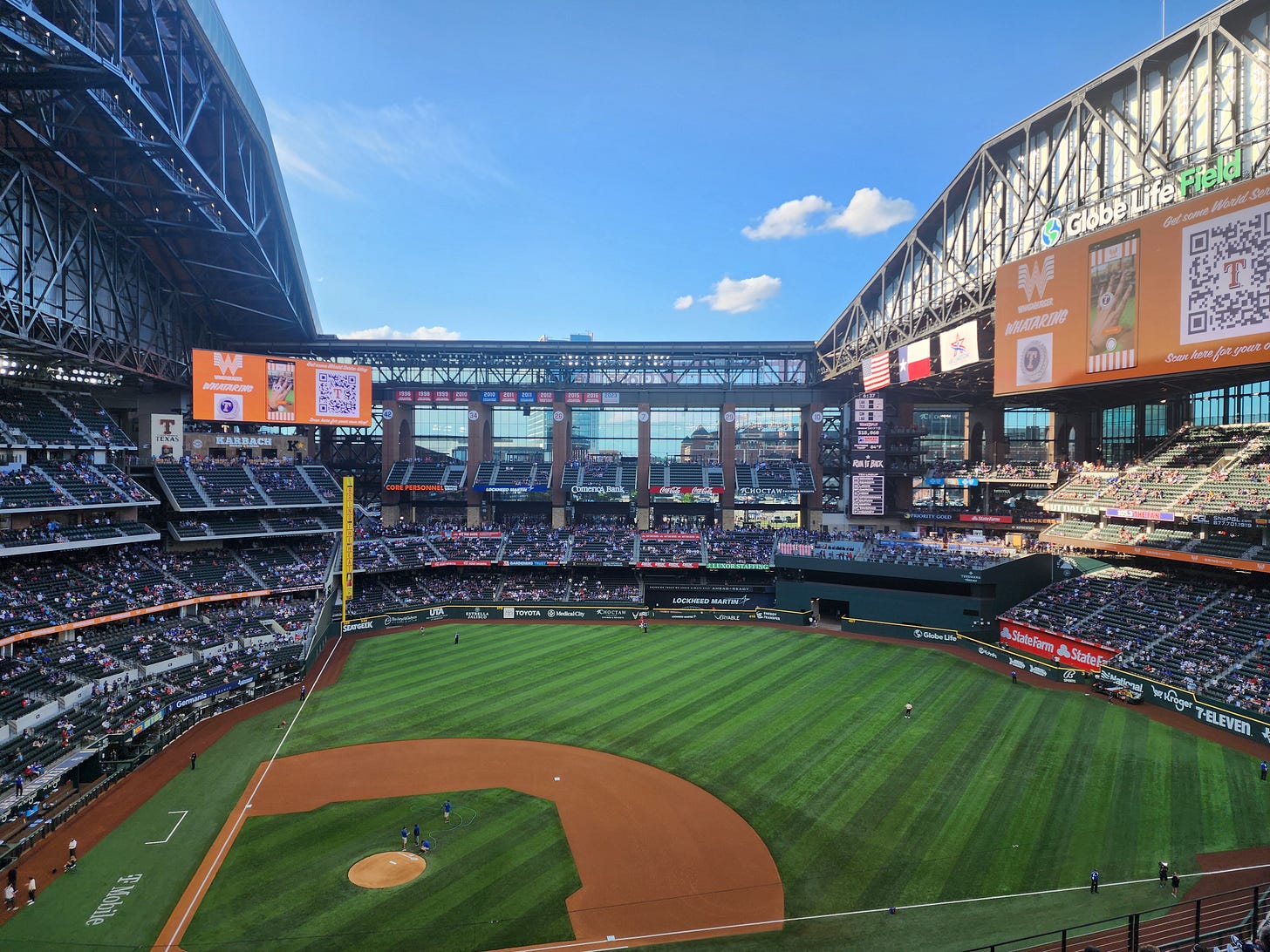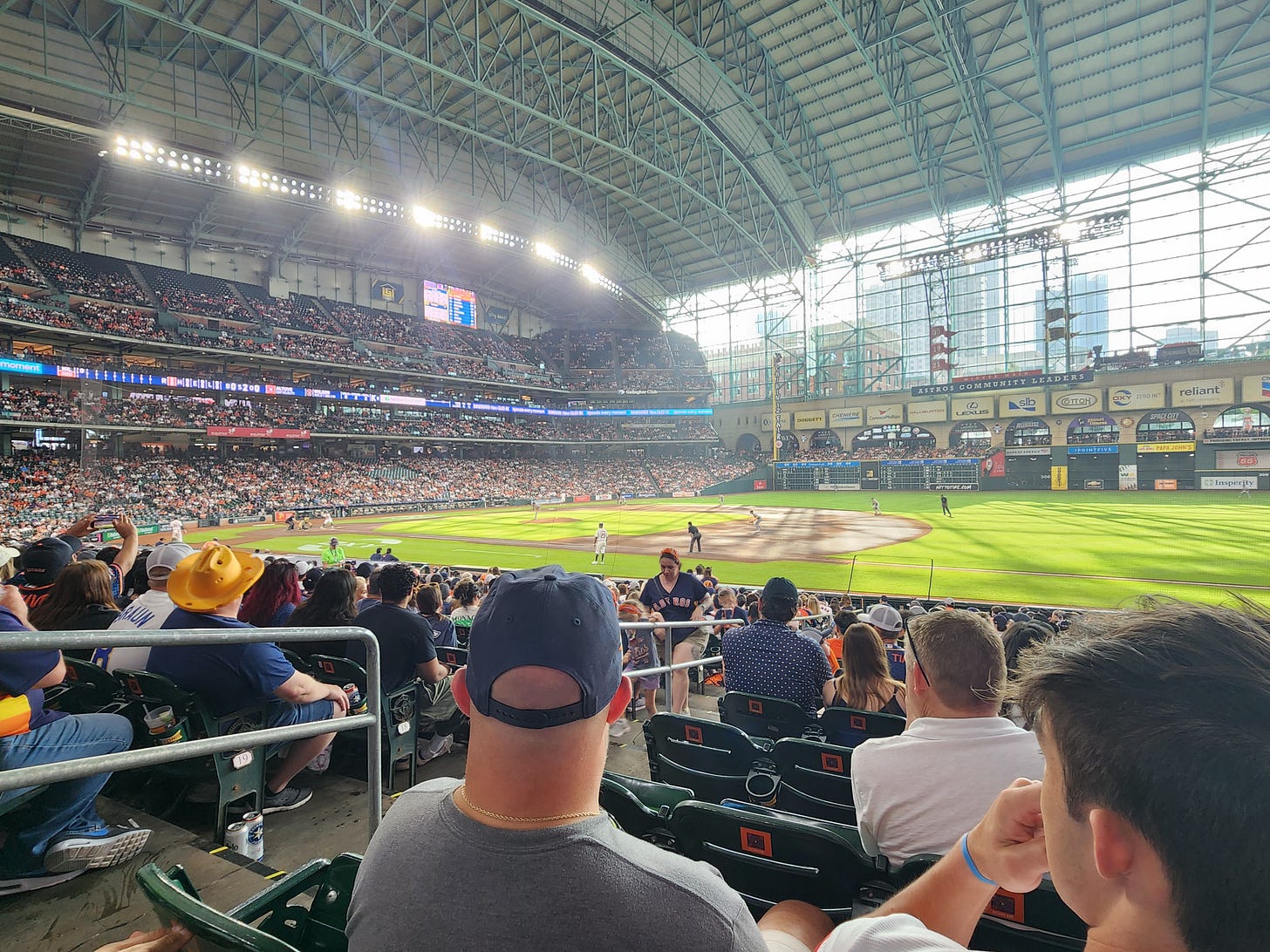Greetings new subscribers! I assume you’re here because of Baseball: The Movie, which thrills me in ways that are hard to describe. So just trust me: I’m thrilled.
What you’ll find here are essays about baseball, baseball movies, fandom, and sometimes just movies in general. There will be Oscar pieces come Oscar time. It’s all free, although there are some old essays behind a paywall and I might occasionally write a piece only for paid subscribers. But I don’t anticipate that being a big part of my work, so if you want to throw me a few bucks, you’ll have to do it just for the hell of it.
Today, I’d like to give you a peek behind the curtain of the first leg of my book tour. I’m paying for the whole tour myself. From what I hear, that’s fairly standard these days, but my publisher in particular mostly publishes books with only regional appeal, so they’re not up for flying me or anyone else all around the country. But this is my first book, it means a lot to me, and I want to get out and meet the people who are excited about it. So off I go.
I did a few New York events, and then flew to Texas for a reading in Dallas and a signing in Houston. So far, it has been a blast. The attendance has been modest, but the people who are there are very happy to be there. It’s like they’ve been waiting for someone to write a book about baseball movies and come to their town to talk about it for their whole life. One very nice woman told me that the event she attended was the best night of her life since Sandy Koufax signed a ball for her. I swear I’m not making that up. She said he was a mensch, and that I was also one.
In between events, I’ve also taken the opportunity to watch some road baseball. Like most lifelong baseball fans, I have a secret dream to visit every MLB stadium, a task that gets harder every time they tear one down. At 44 years old, I’ve already been to quite a few stadiums that no longer exist: Memorial Stadium, Three Rivers Stadium, Olympic Stadium, the old Yankees Stadium, and of course, my beloved Shea. It’s a race against time, and I’m bound to lose. The pursuit is its own reward, though, so I checked a couple more stadiums off my list while I was in Texas.
First, I went to Globe Life Stadium in Arlington, where the Rangers hosted the Angels. I hated almost everything about this stadium. It has no sense of place or history, and no connection at all to the natural world. It is located thirty minutes outside of Dallas in a complex that includes an entertainment venue and Arlington Stadium, the former home of the Rangers that is now used for soccer. There’s nothing around except for parking lots. I always prefer when a stadium is located within the city limits, as that’s how it was in baseball’s early days. Strangely enough, the Dallas Mavericks (NBA) and Stars (NHL) play at American Airlines Arena, which is in Dallas proper, but Rangers fans have to drive for thirty minutes to get to their stadium (and then walk about 30 minutes from the parking lots, but that’s another story).
I finally got to the stadium, which to its credit has a very cool outdoor area with bars and restaurants. For me, the story is always inside, though, so I rushed right in. Your first steps inside any stadium built after 1992 is always a surreal experience. They’re all designed on the same model, the same open concourse, the same layout for its vendors. Only the details change. I felt like I was in a time travel movie where someone killed a bug in the prehistoric era and now everything is the same but just a little bit different. It’s eerie.
The big difference between Globe Life and Citi Field, my home stadium, is that the former has a retractable roof, which was closed when I arrived even though the weather was lovely. In general, I’m not a fan of domes or retractable roofs, but they are becoming more useful as extreme weather increasingly disrupts the MLB schedule. By the time I got to my seat, they had opened the roof, but the weird thing is that it didn’t feel open. Globe Life Field felt like little more than an open-air gymnasium. It was completely closed in, except for the roof itself. You could hardly see anything outside of the stadium. Not like in Pittsburgh, where you can see the walking bridge and the city skyline from every seat, or in Denver, where you can see the Rockies (the mountains and the team) from the right-field stands. Globe Life felt akin to the old donut stadiums built in the 1970s, and that’s not a compliment.
So I wasn’t into the stadium, and the game wasn’t so great either. The Angels jumped ahead and early and never gave up the lead. I had to drive to Houston the next day, so I left in the third inning and began the long walk to the parking lot. I caught a beautiful Texas sunset on the walk, which no one inside the stadium had any idea about.
The other thing I’ll note about the Rangers game is that, while many of the fans were wearing team jerseys bearing the names of their favorite players, almost all of them were from the current team. Maybe it’s to be expected when your team just won a World Series, but I spotted only two Nolan Ryan jerseys in the entire stadium, and I never saw any with the names of Juan Gonzalez, Ivan Rodriguez, or Adrian Beltre. Again, this represents a lack of connection to the team’s history and, in a sense, a lack of connection to the world outside of this stadium’s walls, where those great athletes burnished their legend.
One straight, flat, four-hour drive later, and I was in Houston. The stadium there also has a retractable roof. It’s called Minute Maid Park, otherwise known as the Juice Box. It’s located in downtown Houston, and the second I walked into it, I knew it was different. It wasn’t the open concourse, which felt similar to every other stadium I’ve been in for years. It’s the field itself, which despite being covered by a dome, was covered by wide swaths of light. The northwest side of the stadium has an enormous wall of windows, so that when a game starts in the early evening, the sun streams right through. It gives this domed stadium (yes, technically, the roof is retractable, but from what I hear it’s almost never open) a sense of the pastoral. It connects you to the natural world, and that’s always been the point of baseball.
When professional baseball was invented in the mid-1800s, it was largely played by “gentleman” in urban areas, but the myth of baseball is that it’s a rural sport. Movies like Field of Dreams and The Natural have a lot to do with that, but so does the disproved notion that the game was invented in Cooperstown, New York, a farming community. We believe these myths because baseball reminds us of our rural roots. When the sport became popular in the 1900s and 1910s, it coincided with a huge influx of people from the country to America’s cities. Industrialization was quickly turning the U.S. into an urban nation, and baseball, with its wide open spaces, reminded us of our past. In many ways, it still does. It reminds me of being a child, when the world was big and the backyard of my childhood home felt like an endless field.
The best baseball stadiums reflect this pastoral sensibility. Globe Life Stadium, even with the roof open, doesn’t. Minute Maid Park, even with its roof closed, does. In the next decade, new stadiums will be built. They’re trying to add two new teams, while the A’s are supposedly moving to Las Vegas. Meanwhile, greedy owners will continue trying to bilk taxpayers into footing the bill for unnecessary new parks like the one they’re trying to get done in Kansas City. If and when they do, they’d be wise to remember the lessons of Globe Life and Minute Maid Park. Connect your stadium to the world around it. Baseball can be played in a dome - but not in a vacuum.






Hell, yeah! Stadium reviews!
Dallasite here. I only go to maybe 1-2 games at year, usually when my Tigers are in town, since going to the Rangers requires actually leaving the Dallas city limits. Something I try not to do. It's crazyland out in in the burbs. The new ballpark sucks. It looks like the unholy lovechild of Cowboys Stadium and a metal shed from Home Depot. The "old" ballpark certainly won't be called a classic but it was just find and a fun experience. Although I get why they went with a retractable roof. At the old park, there were certain sections, the left field bleachers where you just didn't sit unless you wanted to be murdered by the Texas sun. The only game I went to personally where those sections were full was the 2011 ALCS.
Back in 2016, when the Rangers started making noise they wanted a new ballpark and the taxpayers to foot a big chunk of the bill, you started seeing stories in the local media about maybe the Rangers could move to downtown Dallas. I am 99% sure those stories were fed to friendly media types by the Rangers to make sure the voters and local government of Arlington would be sufficiently scared about losing the team and to make sure the owners got what they want. Interestingly enough, if the Rangers tried this today there's a decent chance the city of Dallas would try to get them. Our mayor has been very vocal about bring pro sports within the Dallas city limits.
I've had the same observation as you regarding the fans, that you don't see a lot of people wearing jerseys from older players. This puzzled me for a while after I moved here, go to a Tigers game and you're still going to see people wearing jerseys for Trammell or Kaline or Horton or even The Bird. I don't think it's a lack of long-time passionate Rangers fans. There are a lot of those. But it's that Dallas, and by extension DFW as a whole, does not celebrate the past and is always looking to the future. It's both good and bad. The city doesn't remain stuck in the past, but we don't respect or value the past either.